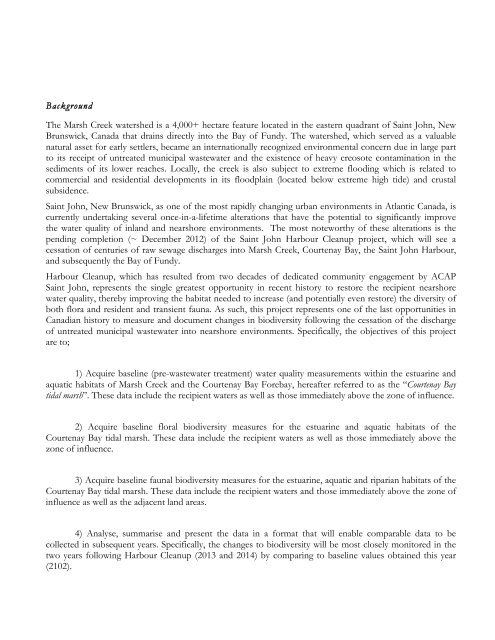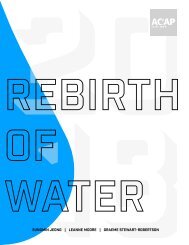Bio-Diversification in the Courtenay Bay Tidal Marsh
“The objectives of this study were to expand our understanding of the environmental attributes of Courtenay Bay, the tidal marsh and estuary of the Marsh Creek watershed. Field studies were conducted to ascertain the occurrence of diadromous fishes and migratory birds within the watershed...”
“The objectives of this study were to expand our understanding of the environmental attributes of Courtenay Bay, the tidal marsh and estuary of the Marsh Creek watershed. Field studies were conducted to ascertain the occurrence of diadromous fishes and migratory birds within the watershed...”
Create successful ePaper yourself
Turn your PDF publications into a flip-book with our unique Google optimized e-Paper software.
Background<br />
The <strong>Marsh</strong> Creek watershed is a 4,000+ hectare feature located <strong>in</strong> <strong>the</strong> eastern quadrant of Sa<strong>in</strong>t John, New<br />
Brunswick, Canada that dra<strong>in</strong>s directly <strong>in</strong>to <strong>the</strong> <strong>Bay</strong> of Fundy. The watershed, which served as a valuable<br />
natural asset for early settlers, became an <strong>in</strong>ternationally recognized environmental concern due <strong>in</strong> large part<br />
to its receipt of untreated municipal wastewater and <strong>the</strong> existence of heavy creosote contam<strong>in</strong>ation <strong>in</strong> <strong>the</strong><br />
sediments of its lower reaches. Locally, <strong>the</strong> creek is also subject to extreme flood<strong>in</strong>g which is related to<br />
commercial and residential developments <strong>in</strong> its floodpla<strong>in</strong> (located below extreme high tide) and crustal<br />
subsidence.<br />
Sa<strong>in</strong>t John, New Brunswick, as one of <strong>the</strong> most rapidly chang<strong>in</strong>g urban environments <strong>in</strong> Atlantic Canada, is<br />
currently undertak<strong>in</strong>g several once-<strong>in</strong>-a-lifetime alterations that have <strong>the</strong> potential to significantly improve<br />
<strong>the</strong> water quality of <strong>in</strong>land and nearshore environments. The most noteworthy of <strong>the</strong>se alterations is <strong>the</strong><br />
pend<strong>in</strong>g completion (~ December 2012) of <strong>the</strong> Sa<strong>in</strong>t John Harbour Cleanup project, which will see a<br />
cessation of centuries of raw sewage discharges <strong>in</strong>to <strong>Marsh</strong> Creek, <strong>Courtenay</strong> <strong>Bay</strong>, <strong>the</strong> Sa<strong>in</strong>t John Harbour,<br />
and subsequently <strong>the</strong> <strong>Bay</strong> of Fundy.<br />
Harbour Cleanup, which has resulted from two decades of dedicated community engagement by ACAP<br />
Sa<strong>in</strong>t John, represents <strong>the</strong> s<strong>in</strong>gle greatest opportunity <strong>in</strong> recent history to restore <strong>the</strong> recipient nearshore<br />
water quality, <strong>the</strong>reby improv<strong>in</strong>g <strong>the</strong> habitat needed to <strong>in</strong>crease (and potentially even restore) <strong>the</strong> diversity of<br />
both flora and resident and transient fauna. As such, this project represents one of <strong>the</strong> last opportunities <strong>in</strong><br />
Canadian history to measure and document changes <strong>in</strong> biodiversity follow<strong>in</strong>g <strong>the</strong> cessation of <strong>the</strong> discharge<br />
of untreated municipal wastewater <strong>in</strong>to nearshore environments. Specifically, <strong>the</strong> objectives of this project<br />
are to;<br />
1) Acquire basel<strong>in</strong>e (pre-wastewater treatment) water quality measurements with<strong>in</strong> <strong>the</strong> estuar<strong>in</strong>e and<br />
aquatic habitats of <strong>Marsh</strong> Creek and <strong>the</strong> <strong>Courtenay</strong> <strong>Bay</strong> Forebay, hereafter referred to as <strong>the</strong> “<strong>Courtenay</strong> <strong>Bay</strong><br />
tidal marsh”. These data <strong>in</strong>clude <strong>the</strong> recipient waters as well as those immediately above <strong>the</strong> zone of <strong>in</strong>fluence.<br />
2) Acquire basel<strong>in</strong>e floral biodiversity measures for <strong>the</strong> estuar<strong>in</strong>e and aquatic habitats of <strong>the</strong><br />
<strong>Courtenay</strong> <strong>Bay</strong> tidal marsh. These data <strong>in</strong>clude <strong>the</strong> recipient waters as well as those immediately above <strong>the</strong><br />
zone of <strong>in</strong>fluence.<br />
3) Acquire basel<strong>in</strong>e faunal biodiversity measures for <strong>the</strong> estuar<strong>in</strong>e, aquatic and riparian habitats of <strong>the</strong><br />
<strong>Courtenay</strong> <strong>Bay</strong> tidal marsh. These data <strong>in</strong>clude <strong>the</strong> recipient waters and those immediately above <strong>the</strong> zone of<br />
<strong>in</strong>fluence as well as <strong>the</strong> adjacent land areas.<br />
4) Analyse, summarise and present <strong>the</strong> data <strong>in</strong> a format that will enable comparable data to be<br />
collected <strong>in</strong> subsequent years. Specifically, <strong>the</strong> changes to biodiversity will be most closely monitored <strong>in</strong> <strong>the</strong><br />
two years follow<strong>in</strong>g Harbour Cleanup (2013 and 2014) by compar<strong>in</strong>g to basel<strong>in</strong>e values obta<strong>in</strong>ed this year<br />
(2102).


















